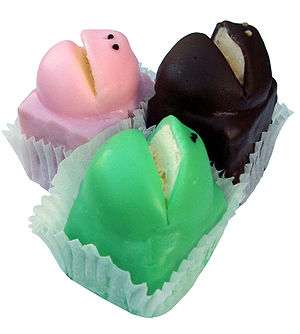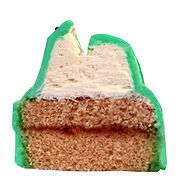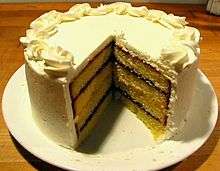Frog cake
The frog cake is a dessert in the shape of a frog's head, composed of sponge cake and cream covered with fondant. It was created by the Balfours bakery in 1922, and soon became a popular treat in South Australia. Originally frog cakes were available exclusively in green, but later brown and pink were added to the range. Since then other variations have been developed, including seasonal varieties (such as snowmen and Easter "chicks"). The frog cake has been called "uniquely South Australian",[1] and has been employed in promoting the state. In recognition of its cultural significance, in 2001 the frog cake was listed as a South Australian Heritage Icon by the National Trust of South Australia. In Denmark, a similar type of cake called a Kajkage ("Kaj cake"), named after a character in the Danish children's television show Kaj & Andrea, is popular.
 A knot of brown, pink and green frog cakes | |
| Course | Dessert |
|---|---|
| Place of origin | Australia |
| Region or state | South Australia |
| Main ingredients | Sponge cake, jam, cream, fondant |
Composition

The frog cake is a small dessert shaped to resemble a frog with its mouth open,[2] consisting of a sponge base with a jam centre, topped in artificial cream and covered with a thick layer of fondant icing. The recipe today remains identical to the one employed when the cake was first produced in the 1920s.[2] When manufactured, large layers of sponge cake are combined and cut mechanically into shape, covered in the fondant,[3] and the mouth is then formed with a hot knife.[4] Fondant eyes of a contrasting colour are manually added to the head, and the completed dessert is presented in a paper patty-pan.[3] The fondant is normally brown, green or pink, but for special occasions colours can include variations such as red and yellow.[2]
History
Having traveled to France in the early 1920s, Gordon Balfour, the nephew of John Balfour, (who was one of the co-founders of Balfours Bakery), found inspiration for the frog cake in European confectionery.[4] The frog cake was introduced by Balfours in 1922 after Gordon's return to Adelaide, during a time in which tearooms were still popular in the city.[5] It soon became known as the Balfours mascot,[5] and has traditionally only been sold in South Australia,[4] although they are now sold in Victoria, New South Wales and Queensland as well.
The original frog cakes were green in colour, and green remains the most popular of the options, but chocolate and pink coloured versions were later added to the range.[5] In addition, while the frog motif dominates, special occasions have resulted in slightly different designs – such as Father Christmas and Snowman cakes released during Christmas seasons and "Chick" cakes around Easter. Frog cakes have also been released in the colours of the Adelaide Football Club.[1]
Frog cakes have long been regarded as a South Australian icon, and have at times been used to help promote the state.[5] For example, in 2001 frog cakes were given to judges during Joan Hall's final pitch in a successful bid to win the 2007 World Police and Fire Games for Adelaide.[6] While there have been tongue-in-cheek and satirical suggestions to build monuments to the frog cake, such as that made by Peter Goers,[7] a more realistic recognition of the frog cake came in 2001 when it was one of the first items to be selected as a South Australian Icon by the National Trust of South Australia during the 165th anniversary of the state,[8] adding the frog cake to the National Heritage Listing as a "movable asset".[3]
Historically, the frog cake has sold well for Balfours, and at times sales have peaked in response to events surrounding the company. When the company was placed into receivership in 2000, a column in The Advertiser by Rex Jory called for people to support the company by purchasing the cakes, and in response sales doubled to an "all-time high".[9] Similarly, the 2001 inclusion of the frog cake as a South Australian icon saw a comparable increase in sales.[4] The success of the frog cake has led to imitations, and in response Balfours registered both the name and the shape of the product as a trademark in 2001.[3][10]
See also
- List of cakes – Wikipedia list article
- South Australian food and drink
- Princess cake – Traditional Swedish layer cake, a broadly similar Swedish dessert
Footnotes
- Jauncey (May 2004)
- Jauncey (2004), p. 211.
- Flanders (2007), p. 36.
- Hockley (26 May 2001), p. 29.
- Clarke (17 June 2003), p. 31.
- Haran (2001)
- Goers (2007)
- Lloyd (7 April 2001), p. 30.
- Hooper (9 November 2000), p. 11.
- "Protection for frog cake" (12 September 2001), p. 9.
References
- Clarke, Daniel (17 June 2003). "Our State South Australia, Diverse, Different and Dynamic Beyond Value". The Advertiser. p. 31.
- Flanders, Anna (ed) (2007). Made in SA. South Australian business: a state of growth. Advertiser Enterprises. p. 36. ISBN 978-0-9599602-5-9.CS1 maint: extra text: authors list (link)
- Goers, Peter (18 August 2007). "A little lunacy on Victoria Square". The Advertiser. Retrieved 17 May 2014.
- Haran, Brady (11 June 2001). "How 8 of these Frog Cakes helped to win 2007 World Police and Fire Games". The Advertiser. p. 8.
- Hockley, Catherine (26 May 2001). "Tuckshop cup cake treat leap-frogs ahead". The Advertiser. p. 29.
- Hooper, Ben (9 November 2000). "Leaping frog cake sales help bakery". The Advertiser. p. 11.
- Jauncey, Dorothy (2004). Bardi Grubs and Frog Cakes: South Australian Words. Oxford University Press. pp. 211–212. ISBN 0-19-551770-9.
- Jauncey, Dorothy (May 2004). "South Australia – 'Kind of Different'?". OzWords. Australian National Dictionary Centre. Retrieved 17 May 2014.
- Lloyd, Tim (7 April 2001). "When pride is a frog cake and Popeye". The Advertiser. p. 30.
- "Protection for frog cake". The Advertiser. 12 September 2001. p. 9.
